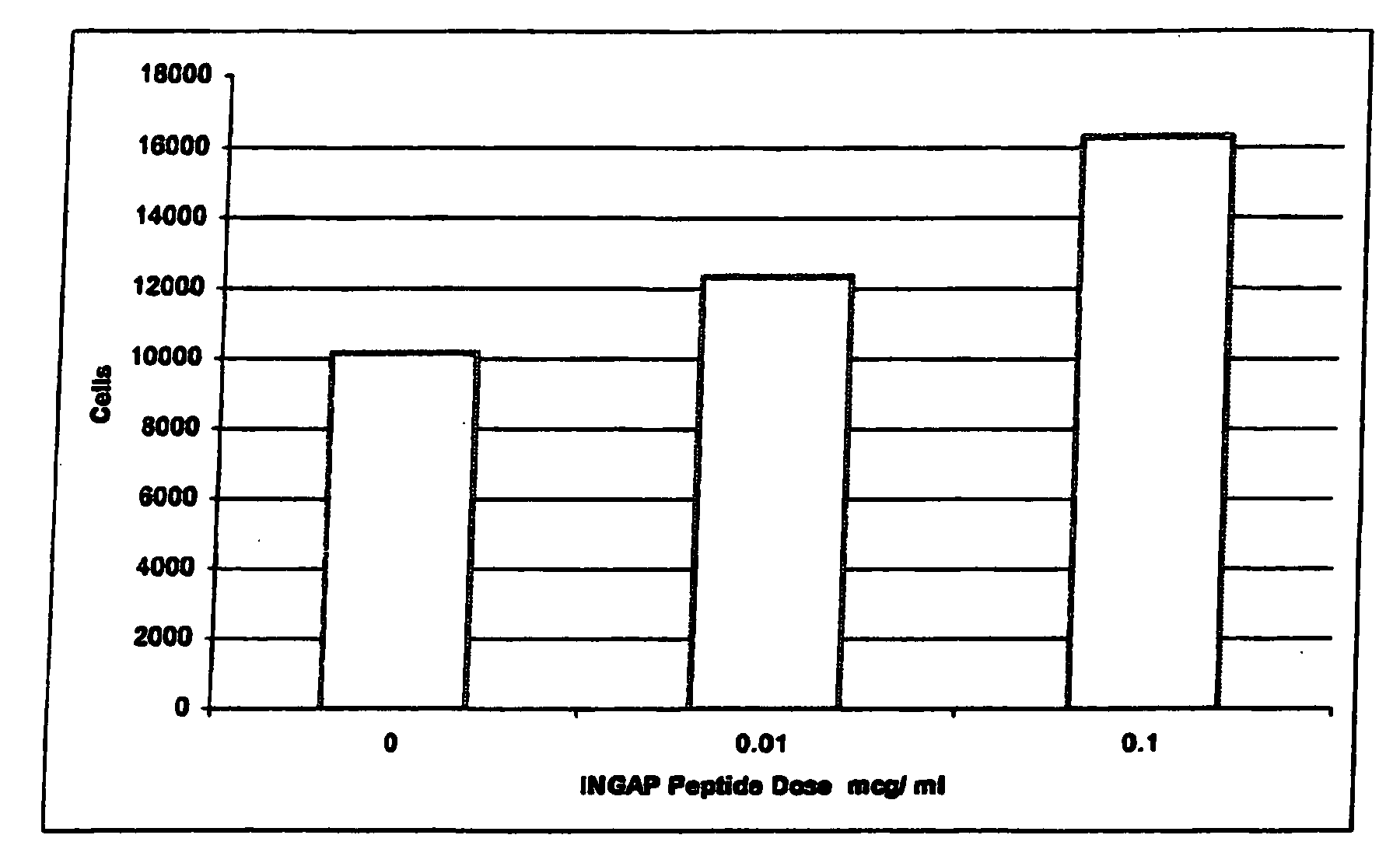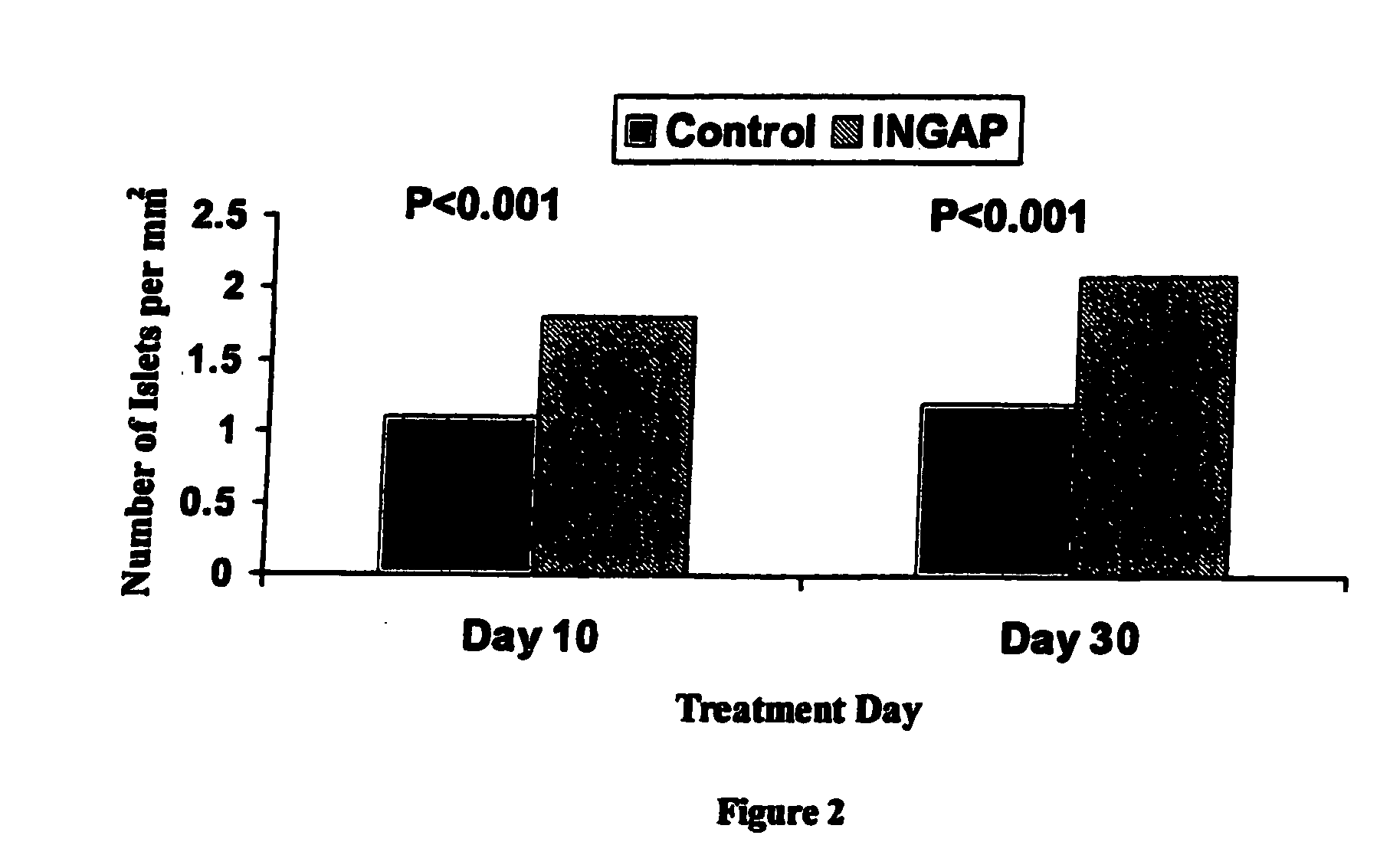Composition and method for treating diabetes
a diabetes and composition technology, applied in the field of diabetes composition and method, can solve the problems of failure of adaptive -cell growth and subsequent deficiency of insulin secretion, and achieve the effect of acceptable stability
- Summary
- Abstract
- Description
- Claims
- Application Information
AI Technical Summary
Benefits of technology
Problems solved by technology
Method used
Image
Examples
example 1
INGAP PEPTIDE SOLUTION FOR INJECTION
[0041]A solution of 120 mg of INGAP Peptide is prepared with the following specifications:
TABLE 1ParameterSpecificationsAppearanceClear colorless solutionAssayEach vial contains90.0% to 110.0% of INGAP PeptideImpuritiesEach Impurity: 1.0%Total Impurities: 3.0%pH4.0 to 5.0Bacterial EndotoxinsNMT 2.92 EU / mgSterilityComplies with USP
example 2
ADMINISTRATION OF INGAP PEPTIDE TO NORMAL HAMSTERS
[0042]INGAP Peptide was studied for its effects on islet formation in normal hamsters. INGAP Peptide 5 mg / kg (25 mg / m2) was given IP daily for 4 weeks and β-cell mass was assessed at 10 days and at 30 days. INGAP Peptide treatment resulted in a significant increase in the number of islets compared with placebo-treated animals (FIG. 2). The islet neogenesis effect was manifested by production of more insulin and an increase in the number of islets in the pancreata. Newly formed β-cells appeared in the wall of, and budding from, pancreatic ducts. These insulin-positive cells resulted from ductal epithelial cell differentiation and islet cell growth, and their appearance was proportional to the dose and duration of treatment with INGAP Peptide. Over longer periods of treatment, these cells migrated away from the duct and formed islets in the parenchyma of the pancreas. After 10 consecutive days of INGAP Peptide administration, there was...
example 3
[0043]C57BL / 6J mice were made diabetic with STZ (35 mg / kg / day×5 days) and divided in INGAP Peptide-treated (250 g twice daily) and saline control groups of 4 animals each. All four of the INGAP Peptide-treated animals had their blood glucose concentrations restored to normal, whereas all of the saline-treated mice remained hyperglycemic (FIG. 3). After 39 days, dosing was stopped and further observation showed durability of the effect to 48 days, when the study was terminated. Histopathologic evaluation of INGAP Peptide-treated animals showed both the presence of normal-appearing islets and areas of new islet formation, including a normal complement and distribution of insulin and glucagon secreting cells (FIGS. 4, and 6). The appearance of glucagon producing cells is noteworthy since glucagon plays a major role in the defense against hypoglycemia. This feature of the INGAP Peptide induced islet neogenesis could help to reverse the impaired counter regulatory c...
PUM
| Property | Measurement | Unit |
|---|---|---|
| Time | aaaaa | aaaaa |
| Mass | aaaaa | aaaaa |
| Mass | aaaaa | aaaaa |
Abstract
Description
Claims
Application Information
 Login to View More
Login to View More - R&D
- Intellectual Property
- Life Sciences
- Materials
- Tech Scout
- Unparalleled Data Quality
- Higher Quality Content
- 60% Fewer Hallucinations
Browse by: Latest US Patents, China's latest patents, Technical Efficacy Thesaurus, Application Domain, Technology Topic, Popular Technical Reports.
© 2025 PatSnap. All rights reserved.Legal|Privacy policy|Modern Slavery Act Transparency Statement|Sitemap|About US| Contact US: help@patsnap.com



